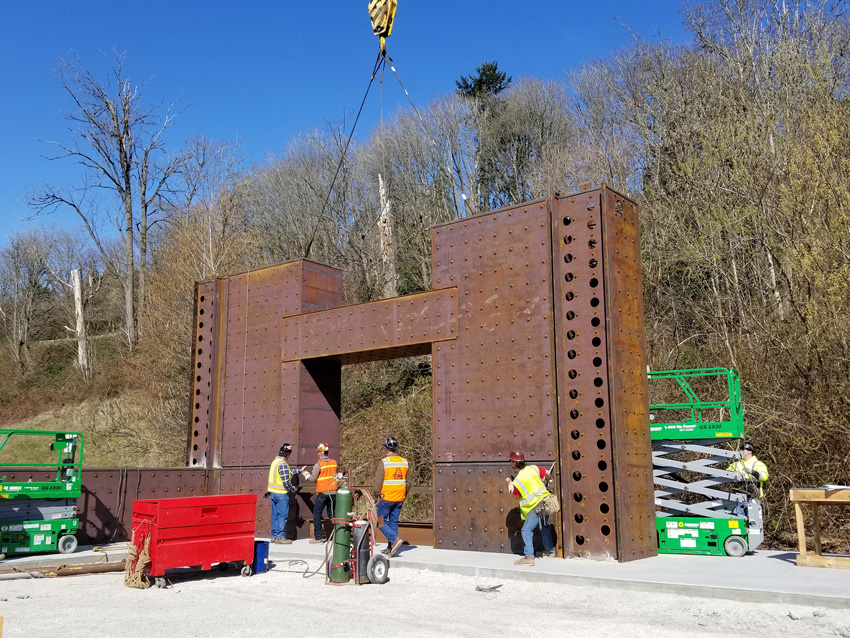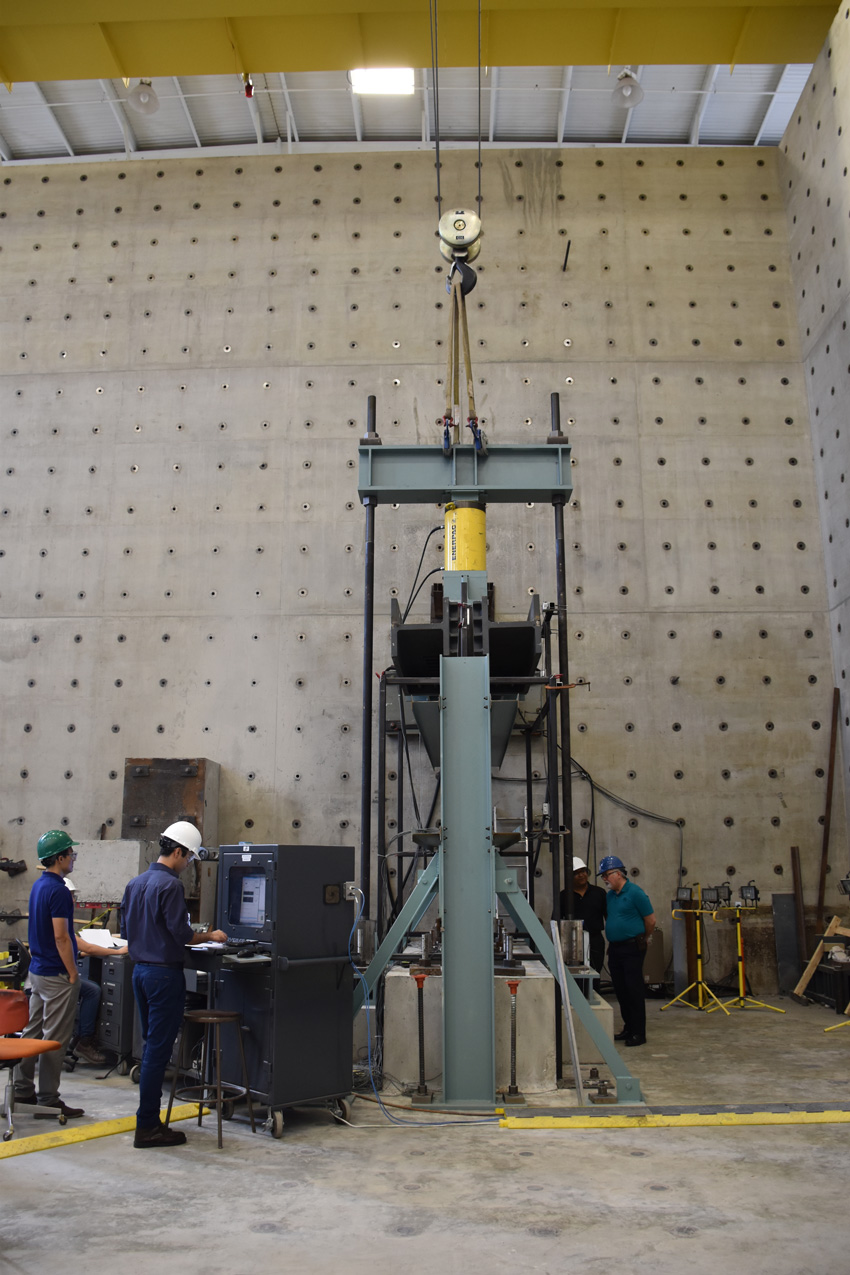Introducing the Steel-Plate Composite Core
Relevant Research
Starting back in 2006, Purdue University studied a nonproprietary version of the Bi-Steel concept with funding from the Charles Pankow Foundation.
“Several aspects of the system were modeled numerically and physically tested, including the stability of the assembly prior to concrete placement forces in the cross-connecting tie rods and a 3/8-scale, 5½-story, T-shaped wall assembly under cyclic loading,” explain Klemencic, Varma, and Morgen.
With the research gathered, detailed design guidelines called “Design Procedure for Dual-Plate Composite Shear Walls” were then created.
While this research is helpful, further testing was needed in order to optimally apply the system to commercial applications, being that nuclear structures have long, squat walls dominated by shear, as compared to high-rise applications, which have tall, slender walls, explains Varma.
Currently, collaborative research is being performed at Purdue University, under Varma’s direction, and Bruneau is heading up another study at the University of Buffalo.

Photo courtesy of MKA
This mockup for Rainiar Square confirmed erection procedures, fit-up, and welding production rates.
Funded by the Charles Pankow Foundation and AISC, and supported with in-kind material donations and expertise from Supreme Group and MKA, the goal is to optimize the CF-CPSW system by reducing the number of crossties and replacing them with shear studs. The research will also inform the next version of AISC’s “Seismic Provisions for Structural Steel Buildings.” Furthermore, AISC and the Charles Pankow Foundation are funding a FEMA P695 study at both universities.
At Purdue, the research keys in on investigating the performance of planar wall panels subject to varying axial loads, considering alternate crosstie arrangement and spacings, with the aim of making the overall system more efficient.

Photo courtesy of AISC
At Purdue University’s Bowen Laboratory, this composite wall test setup is being tested to combined axial load and cyclic lateral loading up to failure.
“The project focuses on the wind and seismic behavior and design of coupled steel plate composite core walls,” Varma explains. “It includes experimental evaluation of the lateral load behavior, including stiffness, strength, and deformation capacity of individual composite walls, including planar walls and C-shaped walls. It also includes experimental evaluation of the coupling beam-to-wall connections and the lateral load behavior of the coupled wall system.”
For the former, the actual assembly test parameters included were an axial load level of 10 to 30 percent of concrete axial load capacity and tie-rod spacing, achieving plate slenderness ratios of 24 to 48. The specimens were ½- to 3/8-scale models of the prototype walls designed for theme structures located in non-seismic and seismic regions.
Meanwhile, at the University of Buffalo, C-shaped and T-shaped wall panels will be tested to investigate the performance of the system with a shifting neutral-axial location, as well as corner detail performance.
The tests will apply 1 million pounds of force to simulate the way an earthquake bends a wall with lateral force. “We want to see how far we can go before we start losing capacity and damaging the wall. We hope to have a better understanding of seismic performance and to validate a number of details,” explains Bruneau. “We will then know how far we can push it.”
“This evaluation will focus on archetype structures—8-, 12-, 20- and 25-story buildings— and their seismic performance as evaluated by implementing the FEMA P695 procedure, adds Varma. The analytical results will be used to inform the seismic design performance factors for the system in the ASCE 7 Standard.
Once the Purdue research is completed in mid-2019, AISC plans to publish a design guide on the system to enable engineers to better understand the proper methods of designing the CF-CPSW system. The FEMA P695 study is planned for completion by the middle of the year and should ultimately yield a seismic response modification factor of R = 8, which is the highest of any shear wall system of any material, according to Kruth.
Currently, Composite Plate Shear Walls – Concrete Filled are addressed in AISC’s “Seismic Provisions for Structural Steel Buildings” and allowed by AISC’s “Specification for Structural Steel Buildings.” Consequently, once these AISC guidelines are adopted in IBC 2018, the CF-CPSW system should become more widely available for use, he adds.
Future Projections
With much at stake as the ground has been laid on Seattle’s Union Street between Fourth and Fifth avenues and erection is ready to begin, the building construction, if executed smoothly, will likely garner much attention as the speed advantage is significant. “Once a successful project is completed, there will be many interested parties,” Klemencic says.
Bruneau agrees that the new system could really change things up in the high-rise market, as it’s a completely different approach to core-wall construction. At the same time, he points out that the structural engineering industry is a conservative profession. “People are used to doing things a certain way, and it takes time to change that momentum,” he says.
Klemencic also acknowledges that owners and contractors tend to be reluctant to be the first to adopt new technology, but with a proven example, which hopefully Rainier will turn out to be, he predicts that the flood gates will open.
“There is significant interest in the coupled steel-plate composite wall system from engineers, fabricators, erectors, and general contractors alike,” relates Varma. “They are all looking at the system for its ability to leverage innovation, research, and design to solve real challenges related to high-rise building construction and economy.”
He adds that with the successful completion of a large-scale project such as the Rainier Square, this should build additional confidence in the industry. Furthermore, the publication of research-based, peer-reviewed design guidelines and recommendations for the system will add additional confidence.
“Moving forward, we believe future applications of this system will result from projects being identified as those that can benefit from the system’s performance and construction techniques, increased comfort in the design, and the willingness of local jurisdictions to entertain such proposals,” Burwell adds.
Summing up the significance of the project’s incorporation of this technology, in a recent Engineering News-Record feature, Klemencic said, “Rainier, Square brings together my insatiable search for ‘better,’ passion for research and development, and intense collaboration with the entire design and construction team to create a breakthrough in how tall buildings are constructed.”
In the same article, Shannon Testa, senior project manager, Lease Crutcher Lewis, the contractor on the project, predicted, “This is going to be a watershed in terms of high-rise construction.”
ENR quotes Malley as concluding, “Potentially, this system could be a game-changer and create unique opportunities beneficial to the marketplace.”

|
The Steel Institute of New York is a not-for-profit association created to advance the interests of the steel construction industry. The institute sponsors programs to help architects, engineers, developers, and construction managers in the New York building community develop engineering solutions using structural steel construction. www.siny.org |








